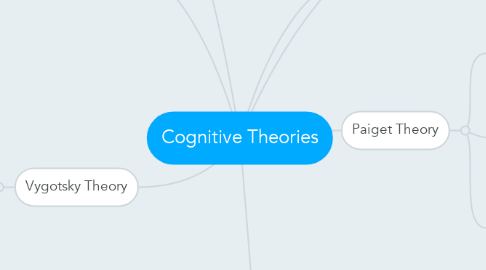
1. Vygotsky Theory
1.1. Main Idea #1
1.1.1. i. Biological factors play a role in cognitive development, therefore there are characteristics and dispositions brought to experiences and because of these variables responses vary accordingly (Ormrod, 2013).
1.2. Main Idea #2
1.2.1. ii. Learners have a zone proximal development in which they are able to complete tasks in three zones. The first zone is accomplishing a task without assistance, the second is that there is some assistance and support needed, and the third is that the learner can not accomplish the task even with considerable assistance and support. According to Ormrod (2013) Vygotsky’s view of actual developmental level is between the first & second level, where are the level of potential development is between the second and third levels.
1.3. Application of Ideas
1.3.1. i. Solving the math problem would have them start with simple parts once they accomplished that then have the instructor guide them to the next part. Finally they may or may not be able to completely classify regardless of the amount of assistance. So in accounting for this example the student would see the instructor do a couple transactions explaining each step and then finally having the student then follow suite, the instructor leading by example.
2. Compare & Contrast
2.1. Compare
2.1.1. Both theories hold cognitive development is in part developing self construct in part of different theories by examining objects and events to build their own understanding of their uses and/ or what is observed of them.
2.2. Contrast
2.2.1. Vygotsky’s in contrast did not believe learning through self construct was a long term solution, rather he emphasized the importance instruction and guidance from others for learners to reach their optimal development. This involved having some assistance with tasks and the learner being able to accomplish the tasks and then even with optimal help with other tasks the learner was not able to accomplish the task to be learned.
3. 21rst Century Learning
3.1. a. The value of Choice Theory, in the respect it is supported through Vygotsky’s Constructivism (1978) is interaction becomes absolutely necessary to cognitive development (Louis, 2009). Continually improving educators’ understanding of how students learn would offer support to the student as they complete tasks that were initially too complex (Louis, 2009). The student is self-regulated allowing knowledge to be understood individually, along with educators to have varied approaches in the learning environment. The educator who embraces Choice Theory supported through the Constructivism Theory provides the learner the tools to maximize their cognitive development (Annala, Makinen, Svard, Silius, & Miilumaki, 2012). With online learning being the fastest growing trend in education for both first time students and returning students the combination of these theories provides the ultimate learning experience for the learner.
4. References
4.1. Annala, J., Makinen, M., Svard, P., Siluis, K., & Miilumaki, T. (2012) Online community environment promoting engagement in higher education. Studies for Learning Society, (2) 2-3. Louis, G. (2009). Using Glasser’s Choice Theory to understand Vygotsky’s. International Journal of Reality, 28(2) 20-23. Ormrod, J. (2013). Eductional Psychology Developing Learners 8th Edition. Pearson Publishing Vygotsky , L. S. (1978). Mind in society: The development of higher psychological processes. Cambridge, MA: Harvard University Press.
5. a. Consistently increasing educators’ understanding of how students learn may offer support to the student as they complete tasks that were initially too complex (Louis, 2009). The student would be self-regulated allowing knowledge to be understood individually, along with educators to have varied approaches in the learning environment. The educator who embraces Vgotsky’s Constructivism Theory (1978) provides the learner the tools to maximize their cognitive development (Annala, Makinen, Svard, Silius, & Miilumaki, 2012).
6. Individual Perspective
7. Paiget Theory
7.1. Main Idea #1
7.1.1. i. Learners construct their knowledge rather than absorb. According to Ormrod (2013) students do not absorb facts and make them a collection rather they pull their experiences together to have a greater understanding. This theory is called the Constructivist Theory.
7.2. Main Idea #2
7.2.1. ii. Learners learn new things through complimentary process of assimilation and accommodation. According to Ormord (2013) assimilation involves using an object or event in the way that represents the way it is used. In regards to accommodation the learner takes the object or event and address the use of the unfamiliar object or event to either modify where it was from or develop a new scheme for the object or event.
7.3. Application of Ideas
7.3.1. i. Student solving a math problem would first start with the foundation or the simplest part of the problem breaking it down into sections. Slowly then adding in the other areas left to compute and build from there. In accounting for example using Paiget’s theory I would give students sets of transactions to journalize. Having them go through each one solving what falls into an asset, liability, or equity.
